What are the standard dimensions of a hockey field. How is the playing area divided. What are the key rules governing gameplay in field hockey. How are penalty corners and strokes awarded and executed.
The Origins and Evolution of Field Hockey
Field hockey boasts a rich history dating back to ancient civilizations. Primitive drawings and carvings from Ancient Greece and Egypt, circa 500 BC, depict figures engaged in a stick-and-ball game resembling modern hockey. Over the centuries, the sport has undergone significant transformations, evolving into the structured and regulated game we know today.
The Fédération Internationale de Hockey (FIH), or International Hockey Federation, serves as the sport’s governing body. Under its auspices, the Rules Committee establishes and updates the laws of the game, ensuring consistency and fairness in competitions worldwide.
Understanding the Basics: How is Field Hockey Played?
Field hockey is a fast-paced team sport that pits two sides of 11 players each against one another. The primary objective is straightforward: score more goals than the opposition within the allotted time frame, typically 60 minutes.

Players utilize specially designed hockey sticks to control, pass, and shoot the ball. These sticks feature a long handle and a curved head with a flat side. Modern sticks are crafted from composite materials such as fiberglass, carbon fiber, and aramid, offering superior performance compared to their wooden predecessors.
Key Equipment Specifications:
- Maximum stick weight: 737 grams
- Stick composition: Laminated fibers (glass, carbon, aramid)
- Ball contact: Only the flat side of the stick may be used
Players must adhere to strict rules regarding ball contact. Using the rounded back of the stick results in a foul known as a “backstick,” with possession awarded to the opposing team.
Hockey Field Dimensions: The Playing Surface Explained
A regulation field hockey pitch is a precisely measured rectangular area, designed to accommodate the sport’s unique requirements. Understanding these dimensions is crucial for players, coaches, and fans alike.
Standard Field Hockey Pitch Measurements:
- Length: 91.4 meters (100 yards)
- Width: 55 meters (60 yards)
- Surface: Modern synthetic materials
The playing area is divided into several key zones, each serving a specific purpose in the game:

- Center Line: Bisects the field, separating the two halves
- 23-meter Lines: Located in each half, 23 meters from the backline
- Striking Circle (D): A semi-circular area with a 14.63-meter diameter, surrounding each goal
The striking circle, often referred to as the “D,” plays a crucial role in scoring. Goals can only be registered if the ball is played from within this area. Any shot taken from outside the circle that enters the goal is disallowed.
Scoring and Gameplay: The Path to Victory
In field hockey, teams strive to outscore their opponents by maneuvering the ball into the opposing goal. This requires a combination of individual skill, teamwork, and strategic play.
How do players advance the ball?
Players use their sticks to pass, dribble, and shoot the ball. Effective ball control and precise passing are essential skills for maintaining possession and creating scoring opportunities. As the game progresses, teams must work together to move the ball up the field and into the striking circle.

What constitutes a valid goal?
For a goal to count, the ball must be played by an attacking player within the striking circle and cross the goal line between the posts and under the crossbar. This rule adds an extra layer of strategy to the game, as teams must work to create high-quality chances within the designated scoring area.
Penalty Corners: A Crucial Scoring Opportunity
Penalty corners, also known as short corners, are among the most exciting and potentially game-changing moments in field hockey. These set plays offer teams a prime opportunity to score and can often determine the outcome of a match.
When are penalty corners awarded?
Umpires typically award penalty corners for the following infractions:
- A defending player commits a foul within the striking circle
- The ball touches a defender’s feet inside the circle
- A serious infringement occurs in the 23-meter area (at the umpire’s discretion)
How is a penalty corner executed?
The attacking team follows a specific procedure to initiate a penalty corner:

- The ball is placed on the backline, 10 meters from the nearest goalpost
- An attacking player pushes the ball towards the top of the striking circle
- Teammates position themselves outside the circle, ready to receive the ball
- Once the ball is stopped just outside the circle, a shot or flick can be attempted
Defending teams are limited to five players, including the goalkeeper, who start behind the goal line. As soon as the ball is pushed out, defenders can rush to block the incoming shot or disrupt the play.
What are the common scoring strategies for penalty corners?
Teams employ various tactics to capitalize on penalty corners:
- Direct Conversion: A specialist player executes a powerful drag-flick, combining speed and accuracy
- Indirect Plays: Teams use pre-planned combinations to create shooting opportunities
- Deception: Attackers may use dummy runs or fake shots to confuse defenders
Penalty Strokes: The Ultimate One-on-One Challenge
A penalty stroke, sometimes called a penalty flick, represents the most severe punishment in field hockey. This dramatic face-off between an attacker and the goalkeeper can be a turning point in any match.
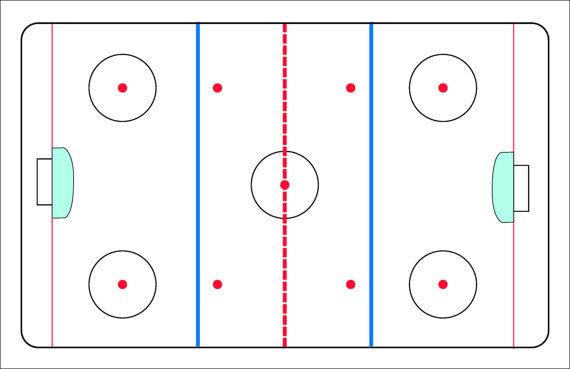
Under what circumstances is a penalty stroke awarded?
Umpires reserve penalty strokes for the most egregious infractions:
- A defending player deliberately prevents a certain goal through illegal means
- A foul occurs in the striking circle that denies a clear goalscoring opportunity
How is a penalty stroke taken?
The procedure for a penalty stroke is as follows:
- The ball is placed on the penalty spot, 6.475 meters directly in front of the goal
- An attacking player faces off against the goalkeeper in a one-on-one situation
- The attacker attempts to score with a single shot or flick
- The goalkeeper tries to save the shot using any part of their body or stick
This high-pressure scenario tests the nerves and skills of both the attacker and the goalkeeper, often with significant consequences for the match outcome.
The Evolution of Hockey Equipment and Playing Surfaces
As field hockey has modernized, so too have the tools and environments of the game. This evolution has had a profound impact on playing styles and strategies.

How have hockey sticks changed over time?
The transition from traditional wooden sticks to modern composite materials marks a significant milestone in the sport’s development:
- Past: Wooden sticks were the norm, offering a classic feel but limited performance
- Present: Composite sticks provide enhanced power, control, and durability
- Future: Ongoing research aims to further optimize stick design and materials
What prompted the shift to synthetic playing surfaces?
The introduction of artificial turf revolutionized field hockey:
- Consistency: Synthetic pitches offer uniform playing conditions regardless of weather
- Speed: The smooth surface allows for faster ball movement and player speeds
- Maintenance: Artificial turf requires less upkeep compared to natural grass fields
This change necessitated adaptations in equipment, playing styles, and training methods to suit the new playing environment.
Tactical Considerations in Modern Field Hockey
Success in field hockey relies heavily on strategic planning and execution. Teams must balance offensive prowess with solid defensive structures to gain an edge over their opponents.

What are some common attacking formations?
Offensive strategies often incorporate the following elements:
- Pressing: Applying high pressure to force turnovers in advantageous positions
- Width: Utilizing the full breadth of the field to stretch opposing defenses
- Overloads: Creating numerical advantages in specific areas of the pitch
How do teams approach defensive organization?
Effective defense in field hockey typically involves:
- Zonal Marking: Assigning players to cover specific areas rather than individual opponents
- Channeling: Directing attacks to less dangerous areas of the field
- Double-Teaming: Using multiple defenders to pressure key attacking players
The interplay between these offensive and defensive tactics creates the dynamic and exciting nature of modern field hockey.
The Global Impact of Field Hockey
Field hockey’s influence extends far beyond the pitch, shaping cultures and fostering international connections. The sport’s global reach continues to grow, driven by passionate players, dedicated fans, and innovative governing bodies.
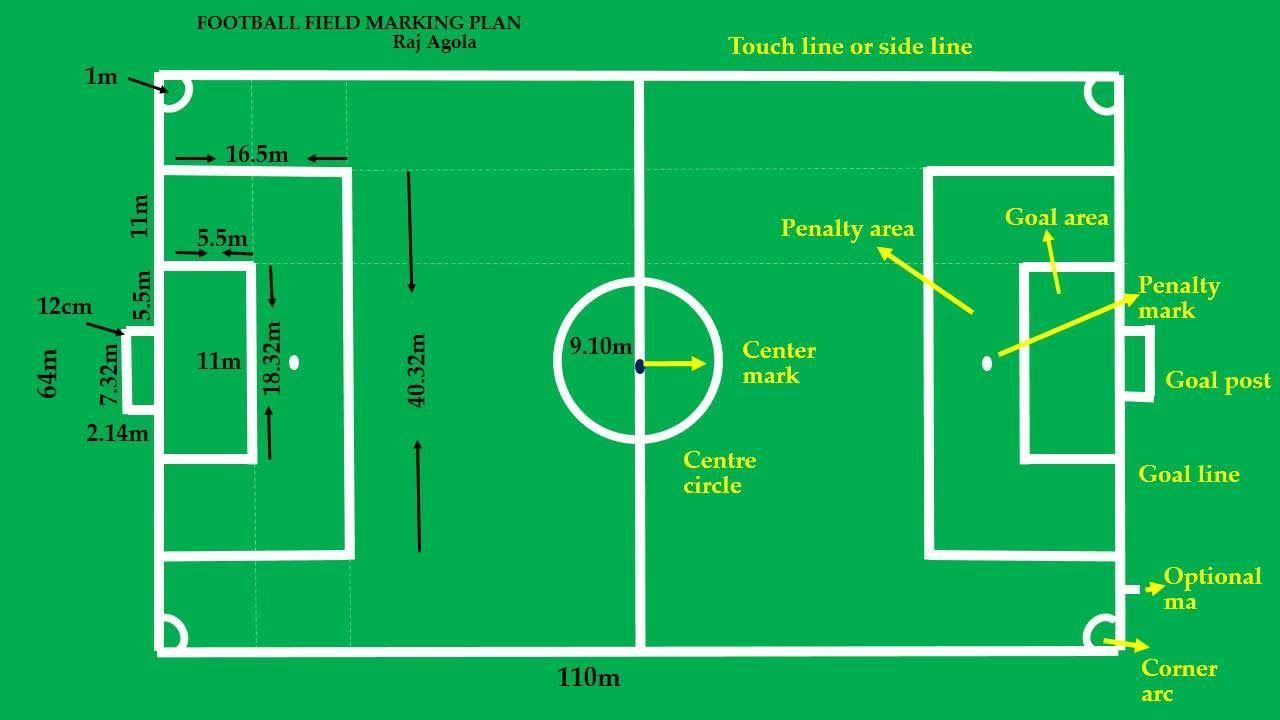
Which countries are considered field hockey powerhouses?
Several nations have established themselves as perennial contenders in international competitions:
- Australia: Known for their aggressive, high-pressing style
- Netherlands: Renowned for technical skill and tactical innovation
- Germany: Celebrated for discipline and efficient team play
- India: Historical giants with a rich hockey heritage
How does field hockey promote cultural exchange?
The sport serves as a vehicle for cross-cultural understanding through:
- International Tournaments: Bringing together athletes from diverse backgrounds
- Youth Development Programs: Fostering connections between young players worldwide
- Coaching Exchanges: Sharing knowledge and best practices across borders
These interactions contribute to the sport’s ongoing evolution and global appeal.
The Future of Field Hockey: Innovations and Challenges
As field hockey continues to evolve, stakeholders must navigate a complex landscape of opportunities and obstacles. The sport’s future will be shaped by technological advancements, changing demographics, and shifting entertainment preferences.

What technological innovations are impacting the game?
Several emerging technologies are poised to transform field hockey:
- Video Assistant Referees (VAR): Enhancing decision-making accuracy
- Player Tracking Systems: Providing in-depth performance analytics
- Smart Equipment: Integrating sensors for real-time data collection
How is field hockey addressing environmental concerns?
The sport is taking steps towards sustainability:
- Eco-Friendly Turfs: Developing playing surfaces with reduced environmental impact
- Water Conservation: Implementing efficient irrigation systems for natural grass pitches
- Carbon Offsetting: Encouraging tournaments to minimize their carbon footprint
These initiatives demonstrate field hockey’s commitment to responsible stewardship of resources.
What strategies are being employed to grow the sport’s fanbase?
Efforts to expand field hockey’s appeal include:
- Digital Engagement: Leveraging social media and streaming platforms to reach new audiences
- Simplified Formats: Introducing shorter, faster-paced versions of the game
- Grassroots Programs: Investing in youth development to cultivate the next generation of players and fans
By addressing these challenges and embracing innovation, field hockey aims to secure its place as a dynamic and beloved sport for years to come.

Know how to play the sport
In a field hockey match, two teams with 11 players each, use specially designed sticks to play for an hour and score goals to win a contest.
(Picture by getty images Germany +491728296845)
With roots dating back to 500 BC, the origin of field hockey can be traced to the early civilizations of Ancient Greece and Egypt.
There are primitive drawings and carvings on walls that depict people playing with a ball and a stick, showing striking resemblance with modern-day hockey.
However, the hockey that we see today has witnessed radical changes and the modern game is played in accordance with a set of rules and regulations formulated by the custodians of the game.
The hockey rules today are made by the Rules Committee, which works under the governing body of hockey, the Fédération Internationale de Hockey (FIH) or the International Federation of Hockey.
Here are some of the common laws of hockey.
Sport Guide: Understanding Hockey
How to play hockey?
The objective of hockey is to score more goals than the opposite team before the stipulated time runs out. All players use a hockey stick to control the ball and drive it in the opposition’s goal post to score for their team.
A hockey stick has a long handle with a curved head, which is flat on one side. The weight of a hockey stick must not exceed 737g. Modern hockey sticks are made from fibres of glass, carbon and aramid.
These fibres are laminated to build strength and sticks are made as per specifications. Earlier, field hockey sticks used to be made of wood. But the introduction of synthetic pitches forced innovations in stick making.
Players are only allowed to use the flat side of the stick to touch the ball. Failure to do so leads to a foul (backstick) and the ball is given to the opposition.
All hockey players need to pass or dribble the ball only with their stick and move it towards the opposite goal. And to score a goal, a shot can only be taken from inside the striking circle.
And to score a goal, a shot can only be taken from inside the striking circle.
To understand the striking circle and the rules associated with it, we need to know the ground’s dimensions and divisions.
Hockey ground measurement
A hockey ground is rectangular in shape, measuring 91.4m in length and 55m in width. Modern pitches are made from synthetic material. The ground is divided into two halves by a centreline and each half is further divided by a 23m line and includes a Dee or the striking circle – a semi-circle with a 14.63m diameter. The goalposts lie within this Dee.
Goals can only be scored from inside the striking circle and any ball that goes in the goal from outside the circle is not counted.
A hockey field is marked with distinct white lines that define the halves and striking circles. (2016 Getty Images)
The circle also comes into play during penalty corners and penalty strokes, which are some of the best opportunities for a team to score goals. These penalties are awarded when the opposition commits a foul in the striking circle.
These penalties are awarded when the opposition commits a foul in the striking circle.
Penalty corner in hockey
A penalty corner is awarded to the opposition when a player commits a foul within the striking circle but not always to thwart a possible goalscoring opportunity.
The most common cause for a penalty corner is the ball touching a player’s feet in the circle.
If an offence takes place outside the striking circle but within the 23m area, the umpire can still award a penalty corner should the offence be severe.
During a penalty corner, the ball is placed 10m from the goalpost on the backline and a player pushes the ball along the carpet towards the top of the striking circle. No attacking player can be inside the Dee. To score, a player has to stop the ball just outside the circle while a team-mate tries to either flick or shoot to score a goal.
There are many strategies to score from a penalty corner. Modern teams employ a drag-flick style where a specialist in the team uses power, precision and quick wrist work to fox the team defending the goal. This is called a direct conversion style. Indirect combination methods are also used to score from penalty corners.
This is called a direct conversion style. Indirect combination methods are also used to score from penalty corners.
During a penalty corner, also called a short corner, not more than five players, including the goalkeeper, can defend the goal. Once the attacking player pushes the ball to the edge of the striking circle, the defenders are allowed to leave the goalline, charge down in a bid to thwart a goal.
Penalty stroke in hockey
A penalty stroke or penalty flick is awarded when an infringement inside the circle denies a certain goal from being scored.
Unlike the penalty corner, the penalty stroke is a one-on-one situation where a goalkeeper is supposed to save a direct shot from the penalty spot, which is 6.475m directly in front of the goal-line.
The attacking player attempts to hit the ball in the goal while the goalkeeper uses his stick and body to prevent the ball from crossing the goalline.
A penalty stroke is perhaps one of the easiest ways to score a goal in field hockey.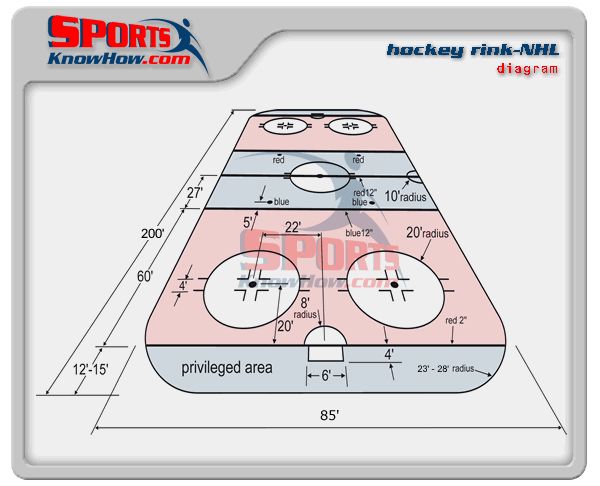 (GETTY IMAGES)
(GETTY IMAGES)
Free hit
A free hit is awarded to a team if the opposing team commits a foul outside the circle. It is taken close to where the offence occurred.
During a free hit, the ball must be stationary and opponents must be standing at least five metres from the ball.
If the ball goes over the backline off the stick of a defending player or the goalkeeper and it is deemed unintentional, play is re-started with the ball on the 23m line and in line with where it crossed the backline. It is often called the 23m restart and rules of a free hit apply in this case.
However, if the defending player plays the ball beyond the backline intentionally and it doesn’t take any deflection from the goalkeeper on the way out, the opposition team is awarded a penalty corner.
How many players in hockey?
In hockey, each team has 11 players, including 10 field players and one goalkeeper. There are five substitutes on the bench and there is no limit to the number of times a player is allowed to be substituted. This is commonly known as rolling substitution.
This is commonly known as rolling substitution.
The field players are commonly categorised into defenders, midfielders and strikers.
The fullbacks, wingbacks, centrebacks and sweepers make up the defensive unit of a team. Its main responsibility is to stop the rival team from scoring a goal.
The forwards, on the other hand, are made up of inside forwards, wingers and centre forwards and their main role is to score goals. In modern hockey, there are no fixed jobs even if players are assigned specific positions.
Meanwhile, the midfielders act as a bridge between forwards and defenders and help in defence as well as offence.
Each team uses a different formation of field players to suit their style of play.
The goalkeeper, meanwhile, is the only player allowed to touch the ball with any part of his body. The goalie wears protective equipment like a helmet, throat collar, body armour, kickers and leg guards at all times and also wears a different coloured jersey.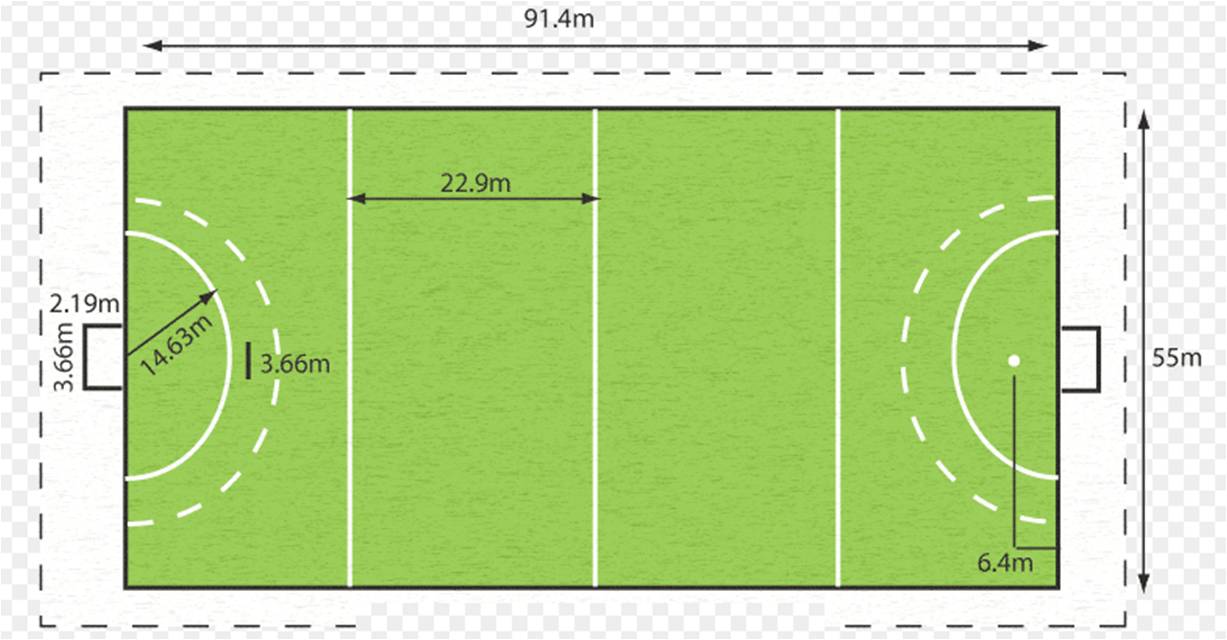
Field hockey time duration
The total duration of a field hockey match is 60 minutes (four quarters of 15 minutes each). Before 2019, matches were played for 70 minutes, with a five-minute halftime break after 35 minutes. The clock is stopped whenever the ball is ‘dead’ due to stoppages like injuries, lost ball or anything that is not in the flow of a game. Effectively, a 60-minute match usually takes longer to finish.
Umpires ensure that no time is wasted during a hockey match. (2019 Getty Images)
The umpires (one in each half of the pitch) are responsible to make sure players do not waste time during a game. Time wasting can invite short suspensions, usually handed out through cards – green or yellow.
How many quarters in hockey?
There are four quarters of 15 minutes each in field hockey. There is a two-minute break after the first and third quarter and a 15 minute-interval after the second quarter, which is halftime.
Add this to your favouritesINDYou may like
Hockey Pitch Dimensions
If you’re looking to install a facility with specific hockey pitch dimensions we offer a specialist design and construction service. The measurements of a standard hockey surface are usually around 91.4m x 55m, and this is the size used for most competitive matches. We are able to install a facility with a smaller area size to fit into existing space at your school or club, and to reduce the overall costs. For facilities which are only used for recreational purposes or practise sessions, the smaller sizes pitches are often the preferred choice.
The measurements of a standard hockey surface are usually around 91.4m x 55m, and this is the size used for most competitive matches. We are able to install a facility with a smaller area size to fit into existing space at your school or club, and to reduce the overall costs. For facilities which are only used for recreational purposes or practise sessions, the smaller sizes pitches are often the preferred choice.
RECEIVE A FREE QUOTE
LEARN MORE NOW
The specifications and costs for every project can vary and we have worked with many different clients to build these outdoor games areas. Please feel free to make contact with us by filling in the quick enquiry box, and we’ll get back to you with some more details of what we can do. Or you can look here – http://www.allweatherpitch.co.uk/ to find out everything you need to know regarding all weather pitches.
Sand Filled Sports Pitches
2G sand-filled hockey surfaces have gotten ever more popular as they can be used in all weather conditions for training and competitive matches. It is not just professional sports clubs who have these surfaces installed, many are found at schools and colleges as well. The sand filled synthetic grass pitches may be installed as a substitute for existing natural grass which might have become muddy or damaged. The artificial carpet creates a fresh appearance for the facility and adds better playing qualities.
It is not just professional sports clubs who have these surfaces installed, many are found at schools and colleges as well. The sand filled synthetic grass pitches may be installed as a substitute for existing natural grass which might have become muddy or damaged. The artificial carpet creates a fresh appearance for the facility and adds better playing qualities.
Ground works and foundation is the very first step for installing a synthetic sport surface. To have the most suitable foundations, the hockey pitch dimensions and measurements must be considered. A sub base will then be put down to ensure the facility is porous, stable and even totally smooth when finished. A shock-pad could also be installed to further improve the level of comfort for the players. The installation of a shockpad can also help to minimise injuries caused to joints and muscles of players using the 2G sport surfacing. The moment the construction process is finished, the sand filled facility will provide permeable qualities, this makes your facility ideal for all-weather use meaning that the 2G pitch may be used all year long.
Constructing a Hockey Court Near Me
If you are looking to construct a hockey court in [LOCATIO] then our specialists are on hand to offer you their services. As experts we have years of experience and professional knowledge so are able to build a hockey court that fits your requirements and is right for you. We can alter all dimnensions and designs to suit you, so get in touch with us today and we will get back to you shortly with everything you require.
Maintaining Astro Turf Surfacing
2G sand dressed pitches http://www.allweatherpitch.co.uk/specification/sand-filled/ are hard-wearing and durable with excellent performance characteristics for hockey. The infill can help enhance the performance characteristics and should be applied across the whole area. Maintaining your sand dressed synthetic pitch is very important to be sure the infill levels are filled up constantly. Routine care really helps to improve the safety and performance characteristics of the sports surface. Contamination can be taken off through brushing and also cleaning. However, if, your pitch does become too dirty and also under contamination, restoration may very well be required. This process is conducted by extracting polluted fine sand and adding clean sand infill.
Contamination can be taken off through brushing and also cleaning. However, if, your pitch does become too dirty and also under contamination, restoration may very well be required. This process is conducted by extracting polluted fine sand and adding clean sand infill.
Outdoor Hockey Field Size
These surface types are very well suited to playing hockey, but they could also be utilised for football and tennis as well. For this surfacing type a thin layer of sand will be installed in the required measurements to hold the grass fibres in place as-well-as allowing balls to move easily over the surface. Having the infill within the turf fibres additionally gives more grip for the gamers using the facility.
TALK TO OUR TEAM
You could also consider having the pitch built in specific dimensions so that it could be applied for other sports. This would create a multi use games area where football and other activities may be played as well. If you wish to improve the sports pitch even more and add more features, we recommend applying more line markings. Sports markings could be added in various colours to help make the surfacing customised. A number of line-markings for different types of activities can be applied, resulting in a MUGA http://www.allweatherpitch.co.uk/dimensions/muga/ where lots of activities are carried out in a single space.
Sports markings could be added in various colours to help make the surfacing customised. A number of line-markings for different types of activities can be applied, resulting in a MUGA http://www.allweatherpitch.co.uk/dimensions/muga/ where lots of activities are carried out in a single space.
Other Dimensions We Offer
- Football Pitch Dimensions – https://www.allweatherpitch.co.uk/dimensions/football/
- Rugby League Pitch Dimensions – https://www.allweatherpitch.co.uk/dimensions/rugby-league/
- Rugby Union Pitch Dimensions – https://www.allweatherpitch.co.uk/dimensions/rugby-union/
- Tennis Court Dimensions – https://www.allweatherpitch.co.uk/dimensions/tennis/
- Netball Court Dimensions – https://www.allweatherpitch.co.uk/dimensions/netball/
- MUGA Court Dimensions – https://www.allweatherpitch.co.uk/dimensions/muga/
Speak To Our Team
We are here to help with any questions you might have about building a new sports facility or carrying out maintenance to an existing one. Our expert installers have worked on many projects with schools, colleges and clubs so we can advise you on all of the different products that are available. Please use the quick contact box to ask about hockey pitch dimensions and the costs for installing these surfaces.
Our expert installers have worked on many projects with schools, colleges and clubs so we can advise you on all of the different products that are available. Please use the quick contact box to ask about hockey pitch dimensions and the costs for installing these surfaces.
KHL and NHL hockey rink sizes – what is the difference
Expert articles
Author Mikhail Strutsky
from 15.09.2021
0
4357
Content:
The result and entertainment of the game is influenced not only by the quality and game form of the team players, but also by the characteristics of the ice rink. The difference in the size of the NHL and KHL hockey rinks is of decisive importance in choosing a game model and in how much easier it will be for players to demonstrate their best qualities to hockey players. This aspect is especially important in international tournaments, in which the host teams appear in a more favorable light, since they do not need time to adapt.
The difference in the size of the NHL and KHL hockey rinks is of decisive importance in choosing a game model and in how much easier it will be for players to demonstrate their best qualities to hockey players. This aspect is especially important in international tournaments, in which the host teams appear in a more favorable light, since they do not need time to adapt.
What is the difference between NHL and KHL rinks? If the ice rinks in the world’s strongest leagues are almost identical in length, then in the NHL they are 4.1 m narrower in width, which significantly affects the nature of the game.
Therefore, hockey players playing for North American clubs have to get used to European parameters and build their game based on them. The same is true for Europeans coming to play in the US or Canada. Therefore, several years ago there were calls to unify the size of the site in the KHL and NHL, so that world hockey would develop according to uniform canons. It seems they were heard by the International Ice Hockey Federation.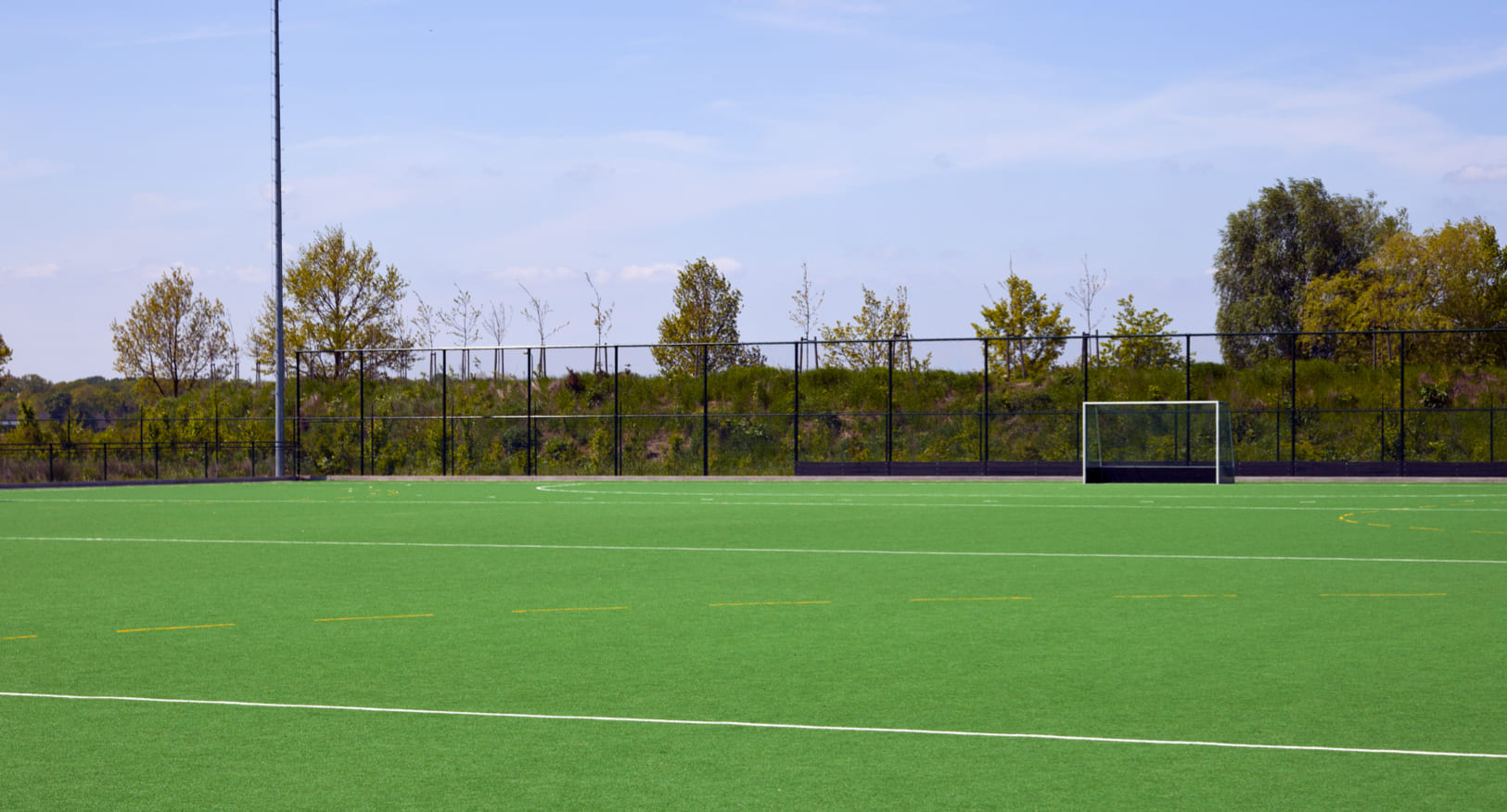
How the difference between the NHL and KHL courts affects the game
With an identical number of players on the North American court, players have less room to maneuver and lack of time to make a decision. Therefore, the speed of the game in Canada and the United States is higher, and the game itself is more dynamic than in European leagues. It is easier for defenders to defend in such arenas, as it becomes easier to conduct a power struggle and less space needs to be covered. Forwards, on the other hand, the European version is more comfortable – the European hockey rink is more suitable for playing combination hockey, which has a large number of fans.
Different sizes of the KHL and NHL hockey rinks significantly affect the nature of the game. In North America, hockey is characterized by more aggressiveness and more shots on goal. In Russia, combinational hockey is still in honor. However, teams that are able to integrate these two styles into their game are more likely to succeed.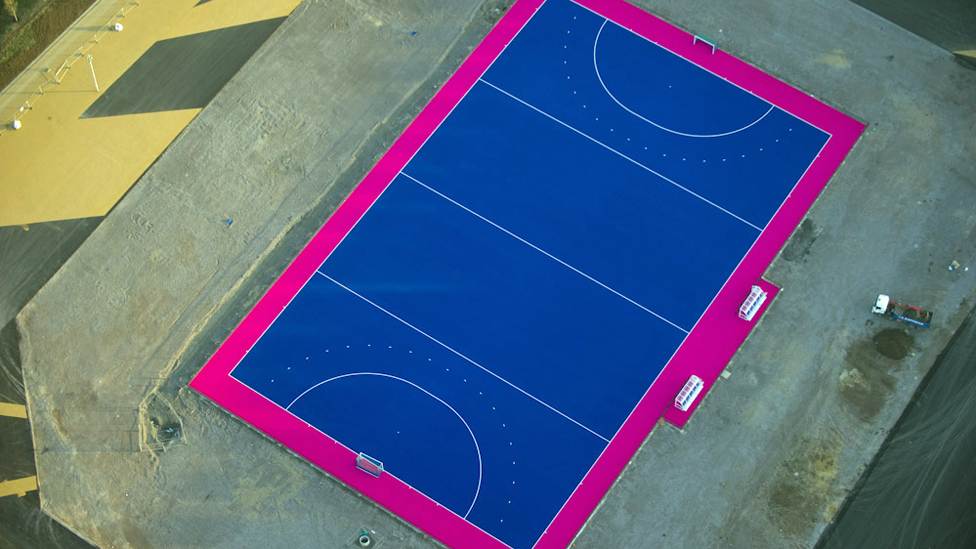
A fateful decision
Since 2020, the International Ice Hockey Federation has approved the size of the Canadian ice hockey rink as the only one possible at the world championships. Since the KHL operates under the auspices of the IIHF, the league teams are moving to smaller ice. This season, the size of the hockey rink in the KHL is again presented in three versions – European, Finnish and Canadian.
The most interesting box type is the Finnish ice hockey rink, which is a compromise between the “Canadian” and the European rink. As the name implies, it appeared in Finland thanks to the desire of the local hockey authorities to speed up the game without losing good conditions for hockey players. The width of the hockey rink decreased by two meters, which made it possible for the participants in the match to more often fight with power and get the goalkeeper after throws. Due to the specific rounding of the sides, the tactics of the teams entering the zone have changed.
Selecting the optimal hockey rink
The size of an NHL hockey rink contributes to a more spectacular game. The shortened width and other design features of the “Canadian” allow you to show the most striking hockey. In such arenas, viscous hockey with a few counterattacks will not bring success. Therefore, it is not surprising that the International Federation, after a comprehensive analysis of all sites, began to transfer world hockey to Canadian sizes.
Will KHL clubs switch to NHL standards? Most clubs justify the rejection of boxes of traditional sizes for European hockey and the transition to the so-called Canadian or Finnish sites by the desire to make matches more spectacular, dynamic and energetic. Although it is worth recognizing that there are enough opponents of such a transition in Russia.
Previously, the first president of the KHL threatened to move to the “Canadian” sites everywhere. However, this idea was not so easy to implement. However, as time has shown, it is quite feasible, since the clubs narrow the ice on their own initiative. So the three field width options are clearly not a final given. Surely, domestic teams will gradually re-equip their hockey rinks for a size of 60 by 26 within a few years, and everything else will become history.
So the three field width options are clearly not a final given. Surely, domestic teams will gradually re-equip their hockey rinks for a size of 60 by 26 within a few years, and everything else will become history.
As the KHL moves towards Canadian hockey rinks, there are curious reports that the NHL is thinking about expanding hockey rinks to give the techies more room for creativity and reduce the number of injuries. If this is implemented, it will become very curious in which direction the development of world hockey will swing.
NHL and KHL hockey rink dimensions
Although the hockey rink is smaller than the football rink, there are no less different graphic designs on it. Let’s talk about everything in detail.
Subject: Sports Notes
Follow us:
Let’s say right away that hockey rinks are different. Nowadays, they are usually divided into two types. The first is NHLovsky, which is slightly smaller and the second, European. The latter complies with the IIHF regulations, so it is worth distinguishing. In the article below we will tell you why each line is needed, and we will write the dimensions in two versions.
The first is NHLovsky, which is slightly smaller and the second, European. The latter complies with the IIHF regulations, so it is worth distinguishing. In the article below we will tell you why each line is needed, and we will write the dimensions in two versions.
The only thing that matches in these sites is their length. In both versions, its length is approximately 60 meters. There are no exceptions here and nowhere. The main and biggest difference is the width of this platform itself. Here the difference is as much as four meters. For understanding, this is about half of the classic room. According to the rules of the IIHF, the width is 30 meters, and in the NHL 26 meters. If we involve primitive mathematics, then we can calculate that the total area of ice in this case differs by more than 100 square meters. Of course, this also affects the style of the game. Therefore, local hockey is so much more dynamic than in Europe. A small space simply does not give time to think.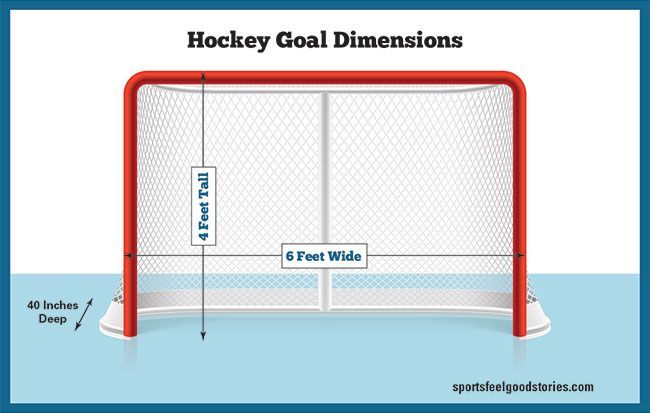
There are also a couple of seemingly minor differences. If in the IIHF the length of the distance from the blue to the red line is 8.6 meters, then in the NHL it is exactly one meter less. The distance from the tailgate to the end line is 3.3 meters, and according to IIHF rules – exactly 4 meters. This means that the middle zone in North America is much smaller than in Europe. In particular, this affects most teams. In the NHL, for a numerical majority, a team gets a lot more space.
Now let’s talk about the rules that are the same everywhere. Why is there a blue line at all? First of all fix offside. The puck must never cross this line later than any player on the team in possession of the puck. To avoid offside, it is enough to leave the blade of the skate on the blue line.
You can also see face-off circles on the court. The dot itself in the center of the circle indicates the face-off point where the referee must throw it. Small corners near the dot indicate the position of the skates of the players at the moment of the face-off, these lines cannot be driven over.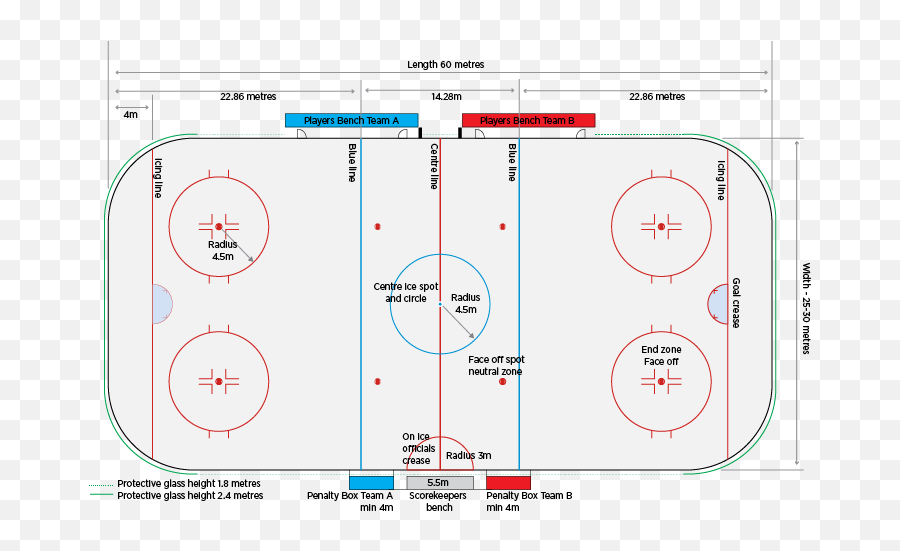 The circle itself means the boundaries in which one of the players cannot be before the face-off. The notches on this circle show the limits in which the players of each of the teams can be at that moment. In the case of a throw-in in the center, everything is simple, there the red line serves as a guide.
The circle itself means the boundaries in which one of the players cannot be before the face-off. The notches on this circle show the limits in which the players of each of the teams can be at that moment. In the case of a throw-in in the center, everything is simple, there the red line serves as a guide.
Special attention deserves the area near the gates, which are most often painted blue. This is the so-called goalkeeper zone. Its function is very simple. None of the attacking players can be inside this zone at the time of the goal, otherwise it simply will not be counted. Well, the last thing left to say is the front line. This is the so-called forward line. If the attacking player threw the puck from his zone and was not the first to reach it, then icing is recorded. This is a new rule, hybrid forwarding. Previously, it was fixed as soon as the puck crossed the end line in the conditions described above. Here are the short marking rules for any hockey rink in the world.